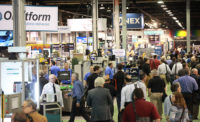Traditionally, the only way to transmit electrical power, data and control signals in a machine is through a physical, metal-to-metal connection.
That’s all well and good for most applications, but it’s not without limitations. Vibrations can loosen connections. Exposure to water or cleaning fluids can threaten the electrical connection or worse, create a hazardous situation. And, a hard-wired connection can limit how far one part of the machine can rotate. For example, wiring limits some robotic axes to less than 360 degrees of travel.
Now, TE Connectivity has introduced a new noncontact technology that promises to change how power, data and signals are transmitted in industrial machinery. Dubbed ARISO, the technology transmits electrical power through inductive coupling. Data and signals are transmitted through 2.4-gigahertz radio-frequency chips with near-field antennas. There are no electrically conducting contacts.
With ARISO, power and data are transmitted via a noncontact electrical connection between a transmitter and a receiver, rather than a direct, metal-to-metal connection. This enables a stationary subsystem of a machine to transfer power to a rotating, indexing or fixed mobile subsystem, such as a gripper. The mobile subsystem can then distribute power to sensors, heaters, cameras, valves, motors, microprocessors or batteries, while it feeds data back to the stationary subsystem.
“If you have a robotic arm, it always has to come back to one original position—it has a maximum freedom of movement of 270 degrees,” says Klaas-Pieter Jimmink, senior marketing manager with TE Connectivity’s Automation and Control Div. “Using ARISO, you can create a robotic arm with a full, 360-degree range of motion. If you install this technology in the robot from the ground to the gripper, imagine how much extra flexibility the robot will have.”
Another advantage of inductively coupled devices is their ability to operate reliably in demanding environments—water, coolant, dust, temperature extremes, vacuum chambers, clean rooms, grease and oil. Hermetically sealed and galvanically isolated, ARISO components carry an IP69 rating.
Signals and power can even be transmitted through nonconductive materials, such as glass or plastic.
And because there’s no direct electrical connection, ARISO components can be safely used in rotating or vibrating equipment. With no moving parts to wear out, the connection is virtually maintenance-free.
ARISO transfers power and data without arcing. Distortion (delay, jitter or noise) is minimal, as long as the subsystems to be connected are within “mating range.” This range is proportional to the diameter of the coupler. For an M12 coupler—the first standard size currently available—the mating range is 3 to 4 millimeters. However, the transmitter and receiver do not have to be perfectly aligned.
The initial version is rated for 24 volts at 6 watts. “But it’s a platform. It’s very scalable,” says Jimmink. “We can make much bigger ones, based on customer requirements for voltage and power, or we can scale it down.”
ARISO couplings will not interfere with wireless equipment on the shop floor, nor will such equipment interfere with the coupling’s ability to transmit power and data.
TARGET MARKETS
Industrial robots are ideal candidates for the new technology, says Jimmink. Besides limiting the robot’s range of motion, power cables are a major source of downtime due to connector failure. To transmit data and power to the robot’s rotating parts, such as the wrist, engineers rely on slip rings, which are mechanically connected to stationary rings via carbon brushes. Those brushes wear out over time, and they’re also a source of particulates—a no-no in clean room environments.
Noncontact transmission of power and data eliminates these issues.
Other applications for the technology include conveyors, indexing tables, milling machines, centrifuges, printing presses, injection molding machines, industrial scales, and food and beverage equipment. ARISO couplers could enable electrical testing of assemblies to be done on the fly. Rather than move an assembly to a dedicated testing area, ARISO sensors can test it as it moves through production.
ARISO technology can be designed into new equipment, or retrofit into existing machines. “It depends on the application,” says Jimmink. “It would be easier to retrofit, say, a food processing machine than a six-axis robot, which may not provide enough room for the cables inside the arm.”
Although TE Connectivity is initially focusing on the industrial market for ARISO, the technology could certainly be used in consumer goods, such as cars and appliances, says Jimmink.
TE Connectivity offers evaluation kits to engineers who are interested in testing ARISO technology in their machine designs. For more information on the ARISO noncontact connection technology, call 401-339-8206 or www.arisocontactlessconnectivity.com.







